The Wild Kingdom Beyond Compare
Story and photography by Terry Check
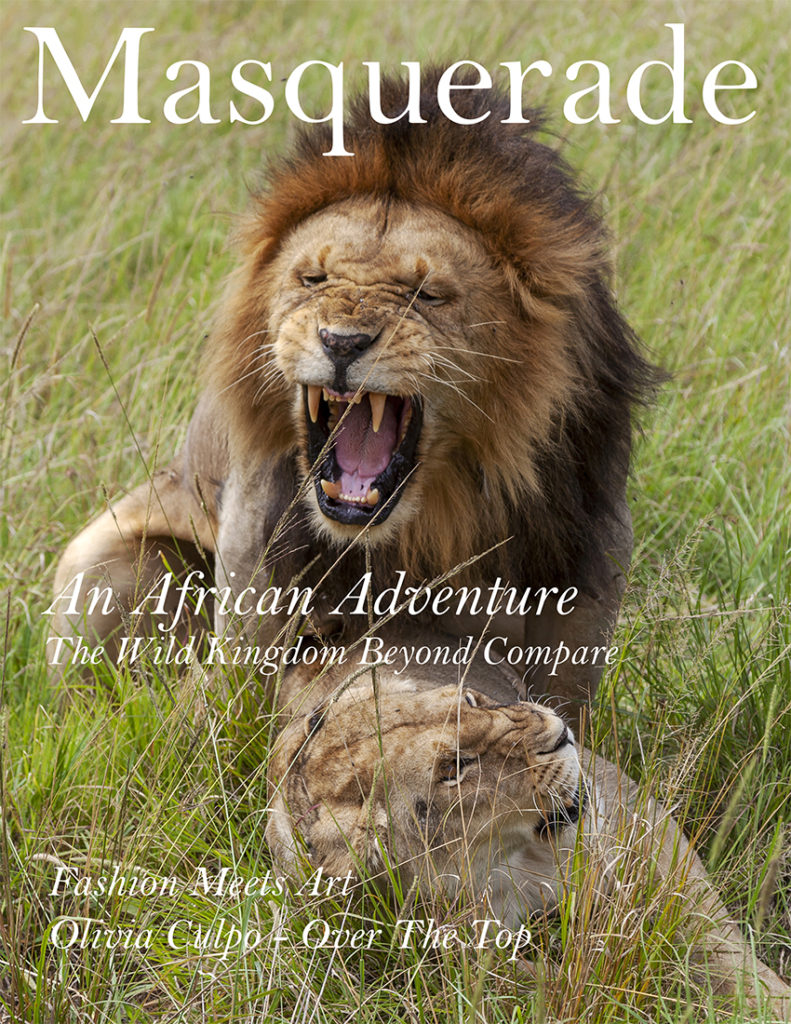
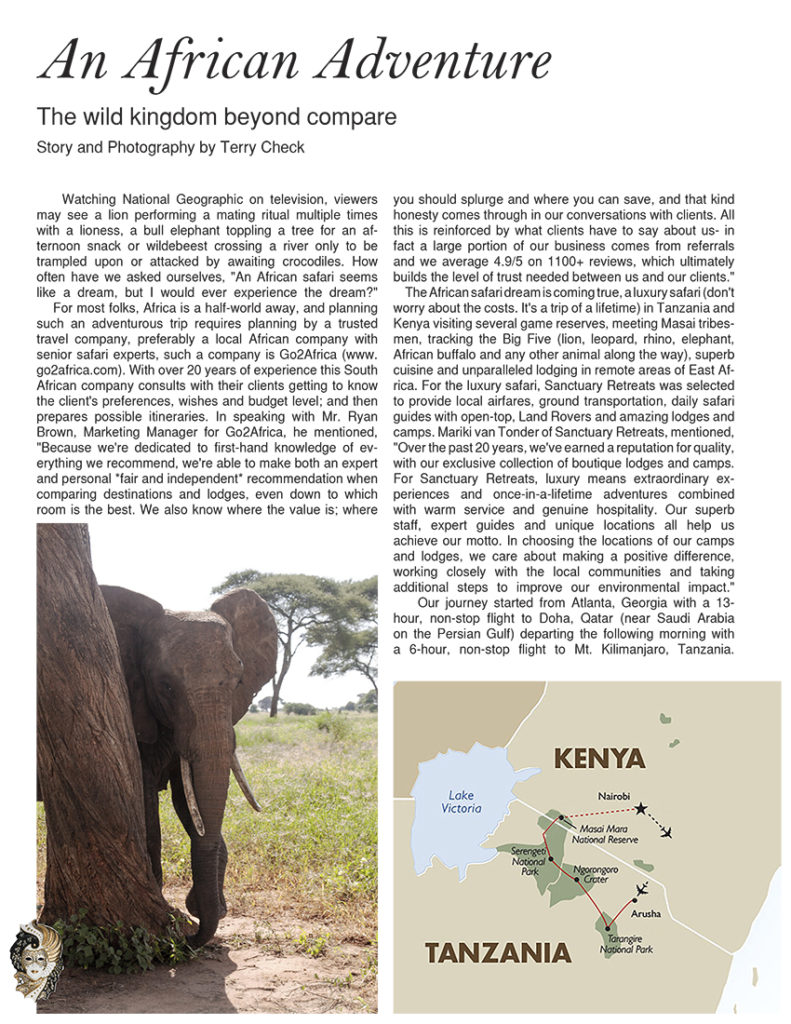
Watching National Geographic on television, viewers may see a lion performing a mating ritual multiple times with a lioness, a bull elephant toppling a tree for an afternoon snack or wildebeest crossing a river only to be trampled upon or attacked by awaiting crocodiles.How often have we asked ourselves, “An African safari seems like a dream, but would I ever experience the dream.”
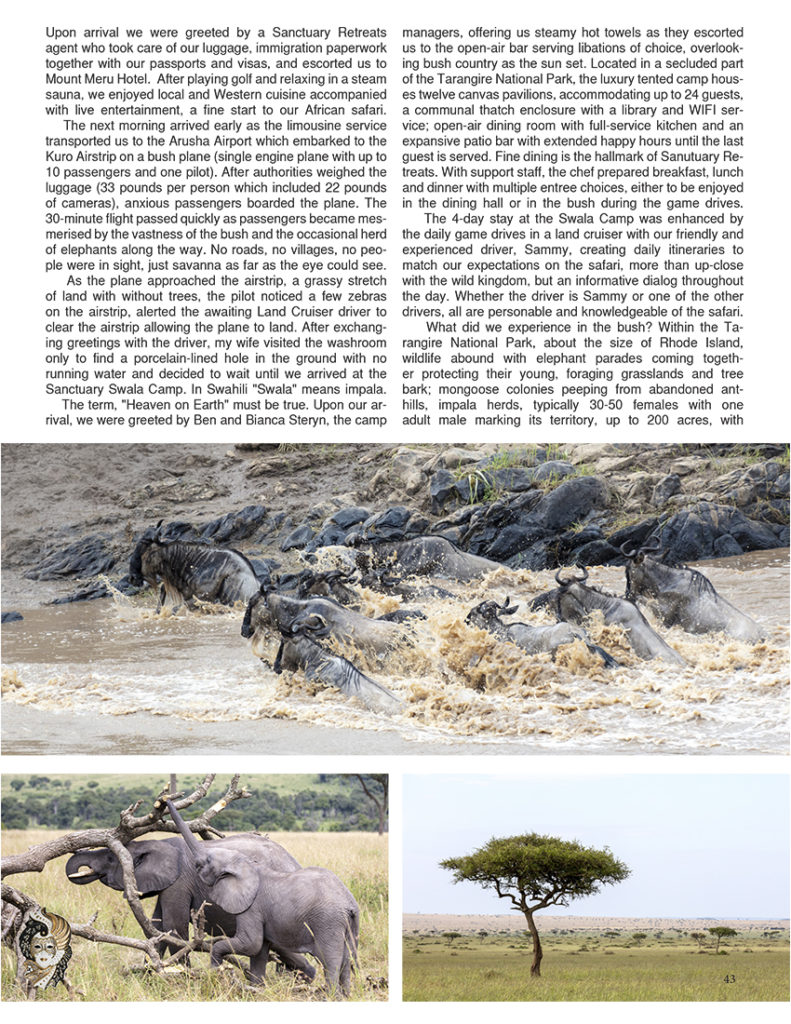
For most folks, Africa is a half-world away, and planning such an adventurous trip requires planning by a trusted travel company, preferably a local African company with senior safari experts, such a company is Go2Africa (www.go2africa.com). With over 20 years of experience thisSouth African company consults with their clients getting to know the client’s preferences, wishes and budget level; and then prepares possible itineraries. In speaking with Mr. Ryan Brown, Marketing Manager for Go2Africa, he mentioned, “Becausewe’re dedicated to first-hand knowledge of everything we recommend, we’re able to make both an expert and personal *fair and independent* recommendation when comparing destinations and lodges, even down to which room is the best. We also know where the value is; where you should splurge and where you can save, and that kind honesty comes through in our conversations with clients. All this is reinforced by what clients have to say about us- in fact a large portion of our business are referrals and we average 4.9/5 on 1100+ reviews, which ultimately builds the level of trust needed between us and our clients.”

The African safari dream is coming true, a luxury safari (don’t worry about the costs. It’s a trip of a lifetime) in Tanzania and Kenya visiting several game reserves, meeting Masai tribesmen, tracking the Big Five (lion, leopard, rhino, elephant, African buffalo and any other animal along the way), superb cuisine and unparalleled lodging in remote areas of East Africa. For the luxury safari, Sanctuary Retreats was selected to provide local airfares, ground transportation, daily safari guides with open-top, Land Rovers and amazing lodges and camps. Mariki van Tonder of Sanctuary Retreats, mentioned, “Over the past 20 years, we’ve earned a reputation for quality, with our exclusive collection of boutique lodges and camps. For Sanctuary Retreats, luxury means extraordinary experiences and once-in-a-lifetime adventures combined with warm service and genuine hospitality. Our superb staff, expert guides and unique locations all help us achieve our motto. In choosing the locations of our camps and lodges, we care about making a positive difference, working closely with the local communities and taking additional steps to improve our environmental impact.”
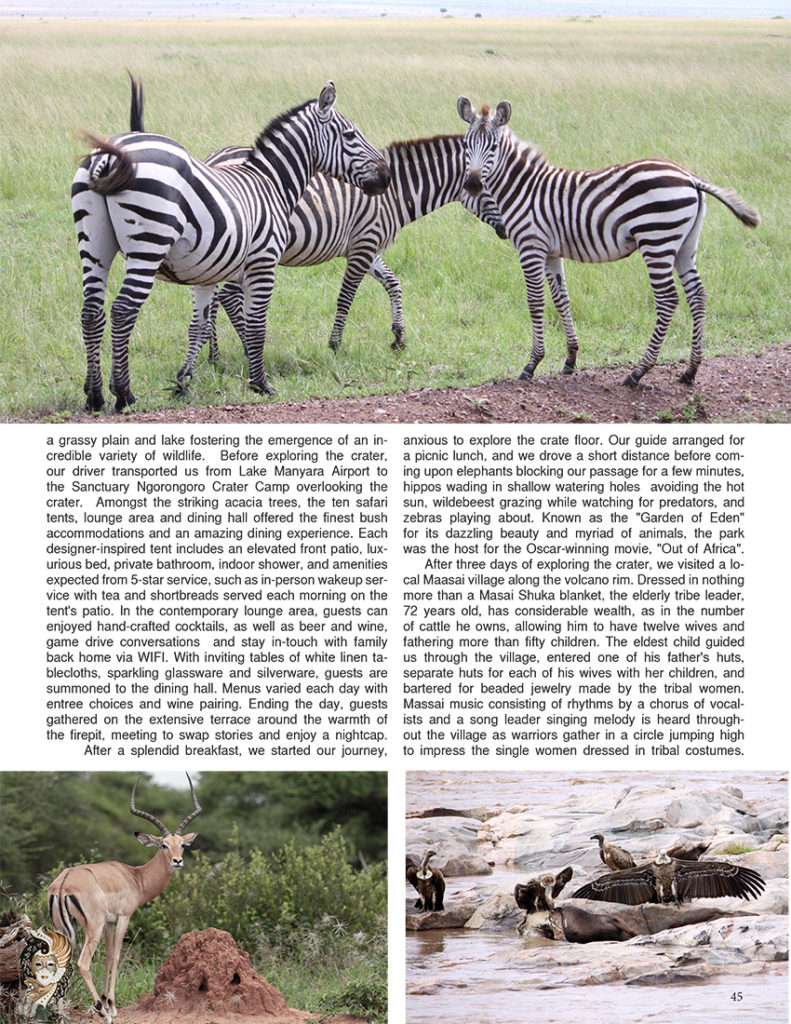
Our journey started from Atlanta, Georgia with a 13-hour, non-stop flight to Doha, Qatar (near Saudi Arabia in the Persian Gulf) departing the following morning with a 6-hour, non-stop flight to Mt. Kilimanjaro, Tanzania. Upon arrival we were greeted by a Sanctuary Retreatsagent who took care of our luggage, immigration paperwork together with our passports and visas, and escorted us to Mount Meru Hotel. After playing golf and relaxing in a steam sauna, we enjoyed local and Western cuisine accompanied with live entertainment, a fine start to our African safari.
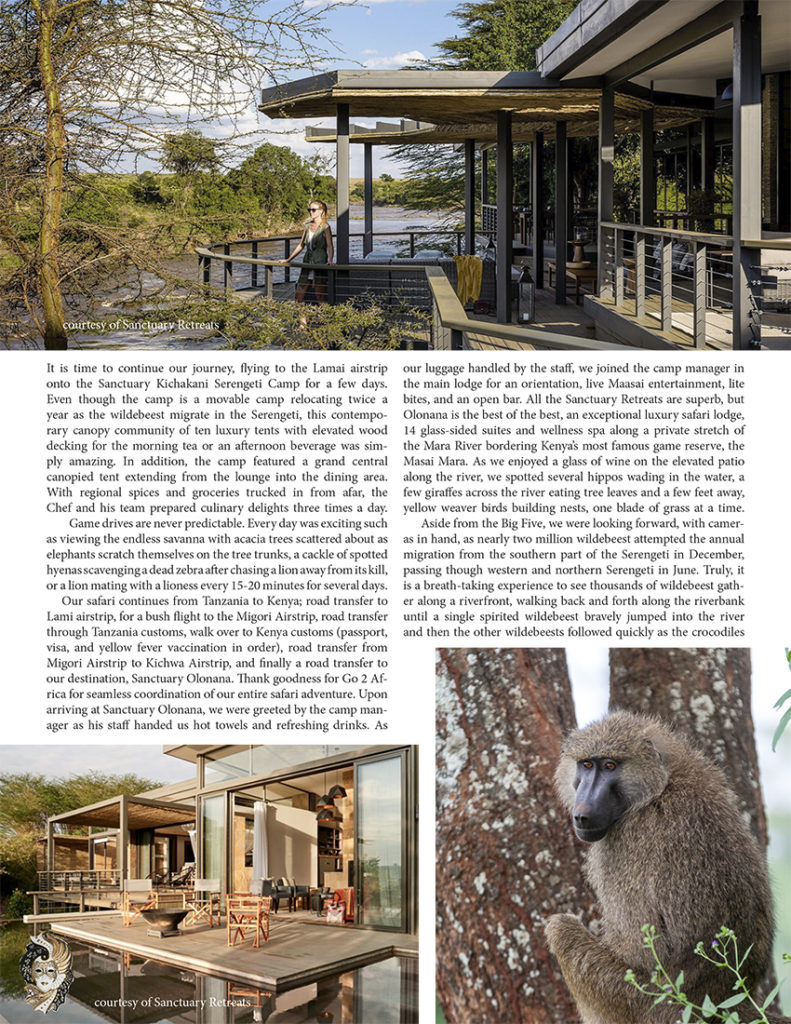
The next morning arrived early as the limousine service transported us to the Arusha Airport to embarked to the Kuro Airstrip on a bush plane (single engine plane with up to 10 passengers total and one pilot). After authorities weighed the luggage (33 pounds per person which included 22 pounds of cameras), anxious passengers boarded the plane. The 30-minute flight passed quickly as passengers becamemesmerised by the vastness of the bush and the occasional herd of elephants along the way. No roads, no villages, no people were in sight, just savanna as far as the eye could see.
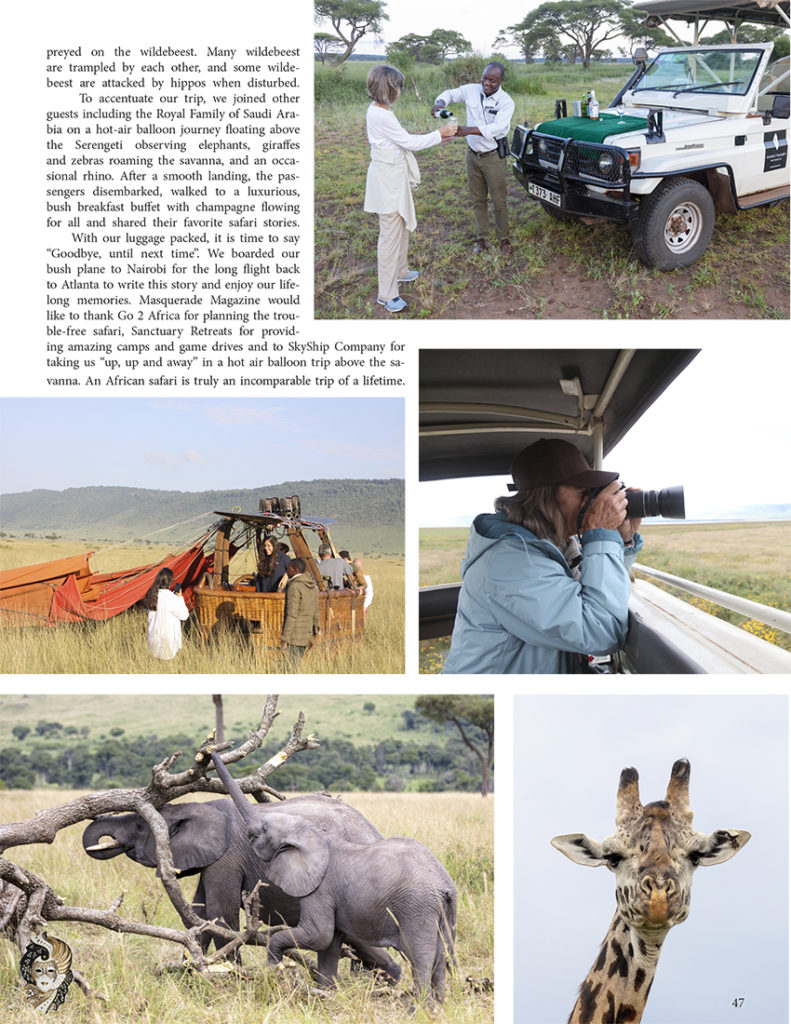
As the plane approached the airstrip, a grassy stretch of land with without trees, the pilot noticed a few zebras on the airstrip, alerted the awaiting Land Cruiser driver to clear the airstrip allowing the plane to land. After exchanging greetings with the driver, my wife visited the washroom only to find a porcelain-lined hole in the ground with no running water and decided to wait until we arrived at the Sanctuary Swala Camp. In Swahili “Swala” means impala.
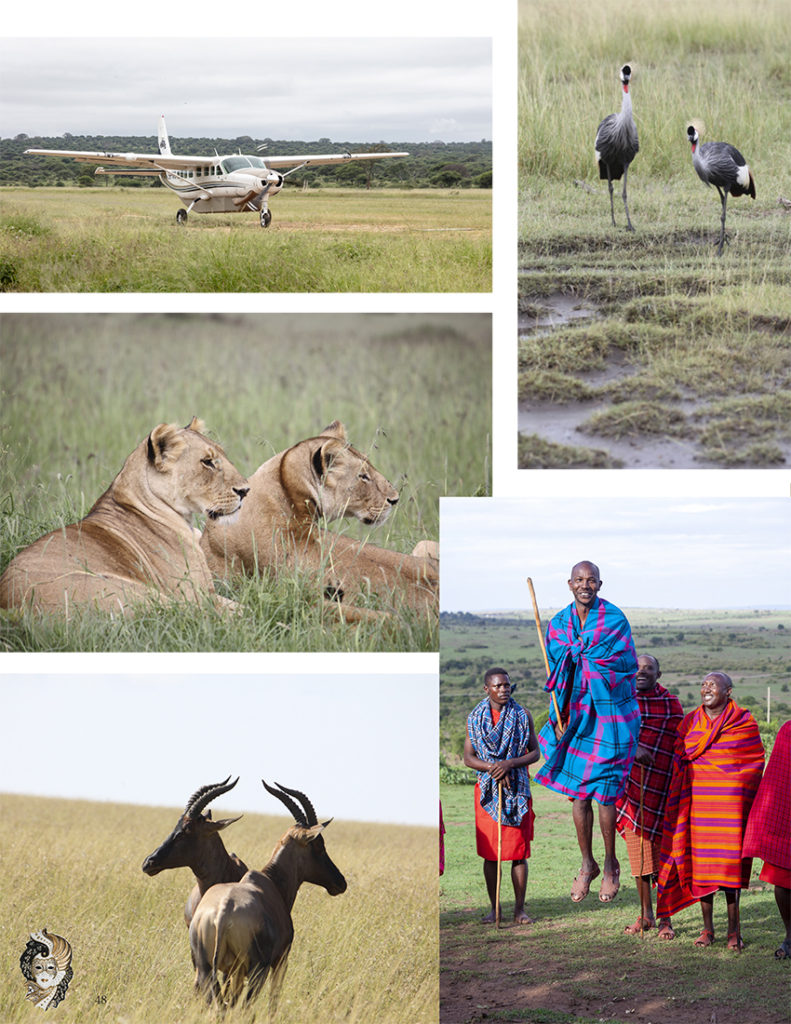
The term, “Heaven on Earth” must be true. Upon our arrival, we were greeted by Ben and Bianca Steryn, the camp managers, offering us steamy hot towels as they escorted us to the open-air bar serving libations of choice, overlooking bush country as the sun set. Located in a secluded part of the Tarangire National Park, the luxury tented camp houses twelve canvas pavilions, accommodating up to 24 guests, a communal thatch enclosure with a library and WIFI service; open-air dining room with full-service kitchen and an expansive patio bar with extended happy hours until the last guest is served. Fine dining is a hallmark of Sanctuary Retreats. With support staff, the chef prepared breakfast, lunch, and dinner with multiple entrée choices, either to be enjoyed in the dining hall or in the bush during the game drives.

The 4-day stay at the Swala Camp was enhanced by the daily game drives in a land cruiser with our friendly and experienced driver, Sammy, creating daily itineraries to match our expectations on the safari, more than up-close with the wild kingdom, but an informative dialog throughout the day. Whether the driver is Sammy or one of the other drivers, all are personable and knowledgeable of the safari.
What did we experience in the bush? Within the Tarangire National Park, about the size of Rhode Island, wildlife abounds with elephant parades coming together providing the young, foraging grasslands and tree bark; mongoose colonies peeping from abandoned anthills, impala herds, typically 30-50 females and one adult male marking its territory, up to 200 acres, with urine and feces.Throughout the year, the wetlands and dry savanna are a natural habitat for over 500 different bird species, a delight for bird watchers.
The next day we decided to forego the bush drive and headed to a neighboring village to meet the rural farmers tending to livestock and bean fields and visit a primary school of 400 children, ages 5-13, arriving eager to learn and hungry. Two hours before the children arrive at school, the teachers have made a wood fire, boiled a large pot of water, and prepared chelalang bean soup for both breakfast and lunch. Before school starts and during the lunch period, the students collect any litter, sweep the dirt driveway and playground, tend to the bean gardens, and hauls water from the elevated storage tank to several water purifiers (donated by Sanctuary Retreats) providing safe drinking water. Sanitary conditions are poor with no running water, no soap, no electricity, and a dilapidated washroom. With 20 stalls, half without doors, the washroom is equipped porcelain-holes in the dirt. During the rainy season, the washroom overflows when in use. USA charitable groups are working together to build a new washroom with running water, flushing squat toilets and hand soap.

Aside from the daily hardships, according to our perspective, the students dressed in uniforms, are extremely attentive, well-mannered, and eager to learn Swahili, English, mathematics, civils and history.

Sorry to say, when it’s time to say “Goodbye”,butwe are eager to return. Next stop is the Ngorongoro Crater, world’s largest inactive, unbroken volcanic caldera, half mile deep and 100 sq. mile cater floor.Two million years ago, the volcano collapsed on itself eventually creating a grassy plain and lake fostering the emergence of an incredible variety of wildlife.Before exploring the crater, our driver transported us from Lake Manyara Airport to the Sanctuary Ngorongoro Crater Camp overlooking the crater. Amongst the striking acacia trees, the ten safari tents, lounge area and dining hall offered the finest bush accommodations and an amazing dining experience. Each designer-inspired tent includesan elevated front patio, luxurious bed, private bathroom, indoor shower, and amenities expected from 5-star service, such as in-person wakeup service with tea and shortbreads served each morning on the tent’s patio. In the contemporary lounge area, guests can enjoy hand-crafted cocktails, as well as beer and wine, game drive conversations and stay in-touch with family back home via WiFi. With inviting tablesof white linen tablecloths, sparkling glassware and silverware, guests are summoned to the dining hall. Menus varied each day with entree choices and wine pairing. Ending the day, guests gathered at the extensive terrace around the warmth of the firepit at night, meeting to swap stories and enjoy a nightcap.
After a splendid breakfast, we started our journey, anxious to explore the crater floor. Our guide arranged for a picnic lunch, and we drove a short distance beforecoming upon elephants blocking our passage for a few minutes, hippos wading in shallow watering holes avoiding the hot sun, wildebeest grazing while watching for predators, and zebras playing about. Known as the “Garden of Eden” for its dazzling beauty and myriad of animals, the park was the host for the Oscar-winning movie, “Out of Africa”.
After three days of exploring the crater, we visited a local Maasai village along the volcano rim. Dressed in nothing more than a Masai Shuka blanket, the elderly tribe leader, 72 years old, has considerable wealth, as in the number of cattle he owns, allowing him to have twelve wives and fathering more than fifty children. The eldest child guided us through the village, entered one of his father’s huts, separate hut for each of his wives with her children, and bartered for beaded jewelry made by the tribal women. Massai music consisting of rhythms by a chorus of vocalists and a song leader singing melody is heard throughout the village as warriors gather in a circle jumping high to impressive the single women dressed in tribal costumes.
It was time to continue our journey, flying to the Lamai airstrip onto the Sanctuary Kichakani Serengeti Camp for a few days. Even though the camp is a movable camp relocating twice a year as the wildebeest migrate in the Serengeti, this contemporary canopy community of ten luxury tents with elevated wood decking for the morning tea or an afternoon beverage was simply amazing. In addition, the camp featured a grand central canopied tent etending from the lounge into the dining area. With regional spices and groceries trucked in from afar, the Chef and his team prepared culinary delights three times a day.

Game drives are never predictable. Every day was exciting such as viewing the endless savanna with acacia trees scattered as elephants scratchedthemselves on the tree trunks, a cackle of spotted hyenas scavenging a dead zebra after chasing a lion away from its kill, or a lion mating with a lioness every 15-20 minutes for several days.
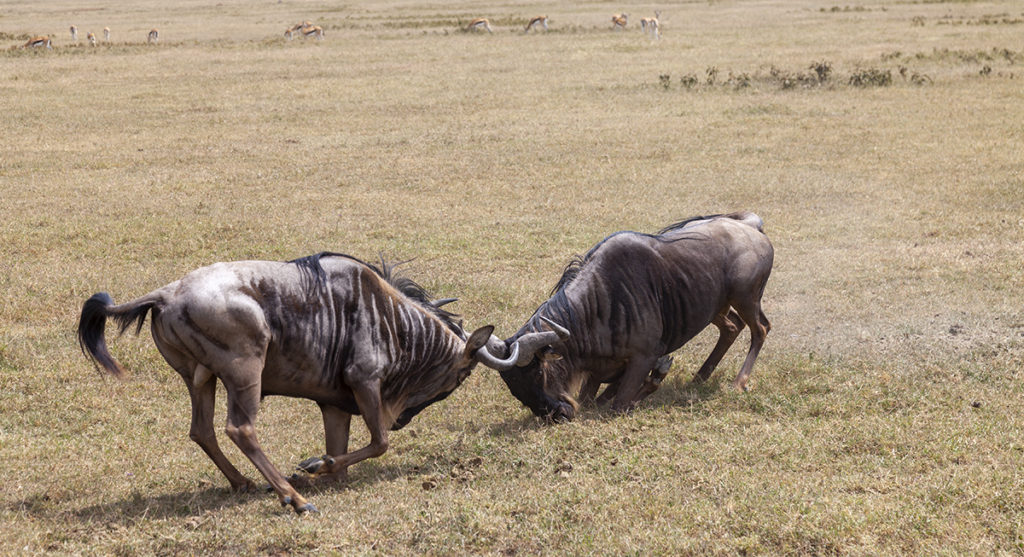
Our safari continues from Tanzania to Kenya; road transfer to Lami airstrip, bush flight Migori Airstrip, road transfer through Tanzania customs, walk over to Kenya customs (passport, visa, and yellow fever vaccination in order), road transfer to Migori Airstrip to Kichwa Airstrip, and finally a road transfer to our destination Sanctuary Olonana. Thank goodness for Go 2 Africa for seamless coordination of our entire safari adventure. Upon arriving at Sanctuary Olonana, we were greeted by the camp manager ashis staff handed us hot towels and refreshing drinks. As our luggage was handled by the staff, we joined the camp manager in the main lodge for an orientation, live Maasai entertainment, lite bites, and an open bar.All the Sanctuary Retreats camps are superb, but Olonana is the best of the best, an exceptional luxury safari lodge, 14 glass-sided suite and wellness spa along a private stretch of the Mara River bordering Kenya’s most famous game reserve, the Masai Mara. As we enjoyed a glass of wine on the elevated patio along the river, we spotted several hippos wading in the water, a few giraffes across the river eating tree leaves and a few feet away,yellow weaver birds building nests, one blade of grass at a time.
Aside from the Big Five, we were looking forward, with cameras in hand, as nearly two million wildebeest attempted the annual migration from the southern part of the Serengeti in December, passing though western and northern Serengeti in June. Truly, it wasa breath-taking experience to see thousands of wildebeests gather along a riverfront, walking back and forth along the riverbank until a single spirited wildebeest bravely jumped into the river and then the other wildebeests followed quickly as the crocodiles preyed on the wildebeests. Many wildebeest are trampled by each other, and some wildebeests are attacked by hippos when disturbed.
To accentuate our trip, we joined other guests including the Royal Family of Saudi Arabia on a hot-air balloon journey floating above the Serengeti observing elephants, giraffes and zebras roaming the savanna, and an occasional rhino. After a smooth landing, the passengers disembarked, walked to a luxurious, bush breakfast buffet with champagne flowing for all and sharing their favorite safari stories.

With our luggage packed, it is time to say “Goodbye, until next time”. We boarded our bushplane to Nairobi for the long flight back to Atlanta to write this story and enjoy our lifelong memories. Mode Lifestyle Magazine would like to thank Go 2 Africa for planning the trouble-free safari, Sanctuary Retreats for providing amazing camps and game drives and to SkyShip Company for taking us “up, up and away” in a hot air balloon trip above the savanna. An African safari is truly an incomparable trip of a lifetime.